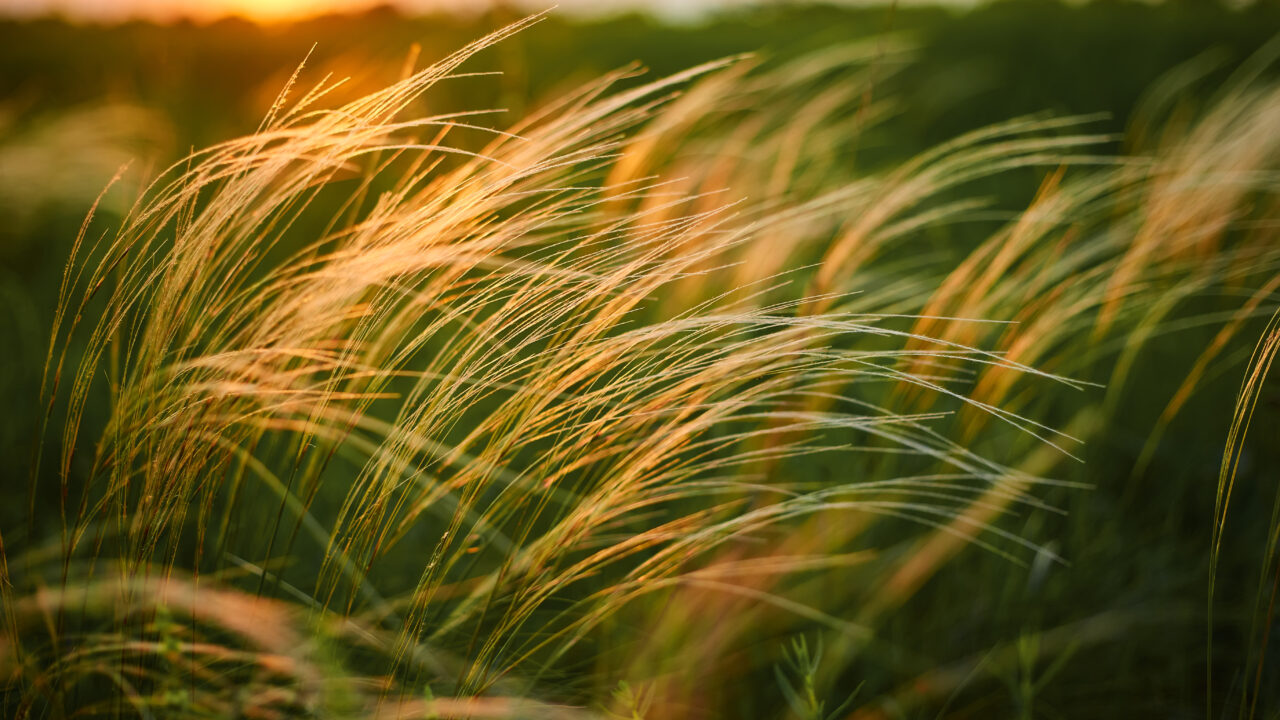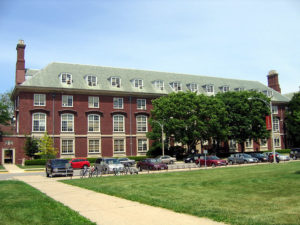On Campus, Indigenous Gardens Cultivate Healing
To decolonize college campuses, BIPOC students, allies, alumni, and faculty are reintroducing Indigenous growing practices. Image: Adobe
Image: Adobe
A walk through any college campus in the United States looks more or less the same: a large open quad with a well-manicured lawn, a historic main hall made of brick and covered in ivy, mature deciduous non-native trees, and colorful flower beds framing the periphery.
“Those are visual clues that you are in an important place of learning,” says Marilyn Marler, a University of Montana natural areas specialist. “This is the standard way that American universities look.”
The common design was an effort by white settlers to recreate the prestigious Ivy League campuses of Princeton, Harvard, and Yale, Marler says. These kinds of landscapes are “all based on European ideals of what is valuable and beautiful,” she says. This has conditioned Americans to associate places of learning with European landscapes instead of local, Indigenous ones.
By dismantling Indigenous landscapes, settler-colonists reimagine them as their own. Environmental historian Traci Brynn Voyles describes the process by which non-white lands are recast as valueless and available for erasure as “wastelanding.”
By dismantling Indigenous landscapes, settler-colonists reimagine them as their own.
The cultural roots of university campus landscapes surround whiteness and a European aesthetic, which can result in Black, Indigenous, and people of color (BIPOC) feeling a sense of isolation and alienation on college campuses, even if there is no overt racial hostility.
Advocates are calling for places of learning to instead be aligned with Indigenous values and aesthetics. The demand for meaningful action has emerged and reverberated throughout institutions of higher education across the country.
“When I think of decolonizing, I think about exercising ways of Indigeneity,” says Sidney Fellows, a Shoshone-Bannock and Chippewa-Cree Master of Science student at the University of Montana. “For me, that means maybe less development, or focusing resources on native plants, maybe creating more areas where we can access foods or things like that when we’re in these college spaces.”
Re-Indigenizing the Settler Colonial Aesthetic
Re-Indigenizing the colonial landscapes of college campuses can address both the historical erasure of Indigenous presence and the isolating impact campuses currently have on BIPOC students, faculty, and staff. Ethnobotanical gardens can create a welcoming and healing space for all—especially for Indigenous participants—through emphasizing human relationships with native plants.
Educational institutions such as Cornell University; Syracuse University; University of California, Berkeley; UC Riverside; Seattle University; Belmont University; Oregon State University; University of Montana; and others have recently established ethnobotanical gardens, native plant gardens, and four sisters gardens as a means to restore Indigenous flora.
The ethnobotany garden outside of the Payne Family Native American Center at the University of Montana (UM) attracted Fellows, who says, “I like to walk around and observe and see what’s growing and know that I can go harvest sweetgrass during a break. … It’s a special place … that I’ve spent a lot of time at.” She says it is a great space that students can visit between classes to unwind.
Ethnobotanical gardens can create a welcoming and healing space for all—especially for Indigenous participants—through emphasizing human relationships with native plants.
Fellows also served as an intern in UM’s Four Sisters Garden. Based on the agricultural practices of the Mandan, Hidatsa, and Arikara tribes, the garden includes sunflowers, squash, corn, and beans, which support one another’s growth. Sunflowers attract pollinators, squash leaves protect the soil from drying out, corn stalks allow vines to climb, and the beans fix nitrogen in the soil. Fellows emphasized that as someone who is not a member of these tribes, “caring [for] these seeds and caretaking for these plants,” requires participants “to be careful about how we’re doing these practices.” In order for campuses to re-Indigenize their landscapes, there is a need to understand what the land and what people’s relationship with that land looked like precolonization.
It is similar at other universities. The modern-day campus of the University of Illinois, Urbana-Champaign, for example, was covered in tall- and mixed-grass prairies until less than 200 years ago. These lands were host and ecological partner of the Bodwéwadmi (Potawatomi), Peewaalia (Peoria), Kaahkaahkia (Kaskaskia), and Myaamia (Miami) since the slow retreat of the last glaciers about 12,000 years ago, according to anthropologist C. Thomas Shay.
Since the 1830s, the Illinois landscape, and especially that of its college campuses, has lost nearly all of its native plant species. Only 0.01% of Illinois’ original Indigenous prairieland remains today. Some of the last remnants were bulldozed in March 2023 by the Greater Rockford Airport Authority just outside Chicago as part of a cargo expansion project. As bulldozers leveled the most pristine prairieland in the state, they were carrying out the task of wastelanding and Indigenous removal in yet another settler-colonial process.
Environmentalist Rob Nixon refers to this kind of centuries-long change in landscape as “slow violence.” Often uncinematic, the damage is real—but its perpetrators are difficult to pin down with specificity.
The erasure of the Indigenous landscape has taken, and continues to take, time. The final violent act of Indigenous removal is to prevent any possibility of Native peoples’ return. On college campuses, as in many places, this is done by imagining they were never here in the first place.
Re-Indigenizing University Campuses
But across the country, advocates are making change. In an effort to re-Indigenize college campuses, BIPOC students, allies, alumni, and faculty are introducing gardens and cultural houses based on Indigenous practices to campuses. While such projects aim to create safe places, they are often on the periphery of the university grounds and not in a central or visible location, adding to the isolation and othering of people of color on college campuses.
In contrast, Oregon State University (OSU) has created both an Indigenous center and a garden in the middle of campus. Director of Tribal Initiatives in Natural Resources Cristina Eisenberg, Latinx with Raramuri and Apache heritage, describes the importance of these places: “[It’s] not just being ourselves, but stepping into our power. And having conversations that we might not have felt safe having here, you know, a decade ago on this campus.”
Eisenberg has been part of the OSU community since 2006, first as a graduate student and then as a postdoctoral researcher. Eisenberg’s background in restoration ecology, wildlife biology, and Traditional Ecological Knowledge frames her work in partnering with tribal nations to support sovereignty rights. “Back in 2006 it was not a safe space to be Indigenous or different,” she says. “It’s very, very different right now.”
Thanks to the efforts of student advocates over the years, OSU now has Native signage and Indigenous plants on campus, and in the future there will be Indigenous cultural burning. Thinking back over her time at OSU, Eisenberg says, “I would have never imagined that we would get to this point.”
In an effort to re-Indigenize college campuses, BIPOC students, allies, alumni, and faculty are introducing gardens and cultural houses based on Indigenous practices to campuses.
By restoring a place’s history, a college community can see the ways that Native plants sustained and continue to sustain Native people, which is why Eisenberg says re-Indigenizing the land is so important today.
The University of Illinois, Urbana-Champaign is still in the process of creating an Indigenous plant garden, but students in the ecological restoration club Red Bison utilize Indigenous knowledge to volunteer and care for native plants at the UI Arboretum.
“It’s a place that not that many students really know about unless they are already seeking it out, myself included,” says Vijay Shah, an Indian-American chemical engineering Ph.D. student. “I take it upon myself to understand the place I am, through learning Indigenous language and learning about Indigenous plants on the land.”
Red Bison has advocated for installing pollinator habitats with native plants in relatively unused land at the center of campus, such as along the periphery of the main quad. Some in the campus community, Shah adds, “may not recognize that a prairie plant restoration, which appears unseemly or disorganized, can actually be healthy in its own right.”
Marler, at the University of Montana, has also noted that when Indigenous plant gardens are attempted on college campuses, some may view them as “ugly” or think they “look bad” because the campus community is not used to this Native aesthetic.
Despite this wastelanding, however unconscious, there is much for everyone in a campus community to gain from restoring Indigenous land connections. Shah described the benefits of pollinator habitats beyond cultural and ecological restoration, recounting that “the more students get to recognize … prairie flowers … it brings people closer to the place [where] they’re studying.”
Another purpose of these kinds of native plant or pollinator gardens is educational. “Most people have plant blindness and they just don’t think about … how plants are organized or what the plants are,” Marler says. By drawing attention to Native plants, appreciation can be cultivated.
Beyond Land Acknowledgements
In recent years colleges and universities have begun writing and presenting “land acknowledgement” statements on their websites and at campus events. But some argue these statements are performative and preclude more meaningful action. University land acknowledgements do not address the process of slow violence or the false colonial narrative perpetuated by these institutions, students say.
The most sensible way to stop slow violence and end waiting for settler-colonists to imbue “wastelands” with value is to intervene.
Fellows shares that while her university in Montana is creating new native plant gardens, it is also continuing to demolish campus green spaces to construct new buildings. “We say those acknowledgements, however here we are … continuing to develop these spaces and … for what? For a football training facility?” she asks. “And what does football represent within our [Indigenous] communities? Who is represented in those communities? What does it mean when we’re putting all this infrastructure and capital into [campus] space?”
More work is still needed, but many advocates are hopeful for the future of re-Indigenizing college campuses—especially in places where Indigenous ethnobotanical gardens have already been successfully established and integrated into campus life.
The most sensible way to stop slow violence and end waiting for settler-colonists to imbue “wastelands” with value is to intervene. This is done by returning to the kinds of landscapes that Indigenous peoples stewarded for some 30,000 years. Centering that history—centering Indigenous presence—can meaningfully transform institutions of power into places of learning.
Your support matters…Independent journalism is under threat and overshadowed by heavily funded mainstream media.
You can help level the playing field. Become a member.
Your tax-deductible contribution keeps us digging beneath the headlines to give you thought-provoking, investigative reporting and analysis that unearths what's really happening- without compromise.
Give today to support our courageous, independent journalists.




You need to be a supporter to comment.
There are currently no responses to this article.
Be the first to respond.